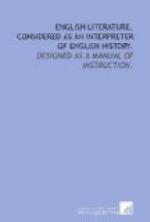Charles Kingsley, born 1809: this accomplished clergyman, who is a canon of Chester, is among the most popular English writers,—a poet, a novelist, and a philosopher. He was first favorably known by a poetical drama on the story of St. Elizabeth of Hungary, entitled The Saint’s Tragedy. Among his other works are: Alton Locke, Tailor and Poet; Hypatia, the Story of a Virgin Martyr; Andromeda; Westward Ho! or the Adventures of Sir Amyas Leigh; Two Years Ago; and Hereward, the Last of the English. This last is a very vivid historical picture of the way in which the man of the fens, under the lead of this powerful outlaw, held out against William the Conqueror. The busy pen of Kingsley has produced numerous lectures, poems, reviews, essays, and some plain and useful sermons. He is now Professor of Modern History at Cambridge.
Charlotte Bronte, 1816-1855: if of an earlier period, this gifted woman would demand a far fuller mention and a more critical notice than can be with justice given of a contemporary. She certainly wrote from the depths of her own consciousness. Jane Eyre, her first great work, was received with intense interest, and was variously criticized. The daughter of a poor clergyman at Haworth, and afterwards a teacher in a school at Brussels, with little knowledge of the world, she produced a powerful book containing much curious philosophy, and took rank at once among the first novelists of the age. Her other works, if not equal to Jane Eyre, are still of great merit, and deal profoundly with the springs of human action. They are: The Professor, Villette, and Shirley. Her characters are portraits of the men and women around her, painted from life; and she speaks boldly of motives and customs which other novelists have touched very delicately. She had two gifted sisters, who were also successful novelists; but who died young. Miss Bronte died a short time after her marriage to Mr. Nichol, her father’s curate. Mrs. Elizabeth Gaskell, her near friend, and the author of a successful novel called Mary Barton, has written an interesting biography of Mrs. Nichol.
George Eliot, born 1820: under this pseudonym, Miss Evans has written several works of great interest. Among these are: Adam Bede; The Mill on the Floss; Romola, an Italian story; Felix Holt; and Silas Marner. Simple, and yet eminently dramatic in scene, character, and interlocution, George Eliot has painted pictures from middle and common life, and is thus the exponent of a large humanity. She is now the wife of the popular author, G. H. Lewes.
Dinah Maria Muloch (Mrs. Craik), born 1826: a versatile writer. She is best known by her novels entitled John Halifax and The Ogilvies.




